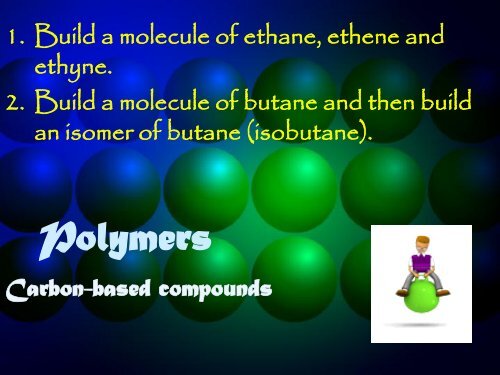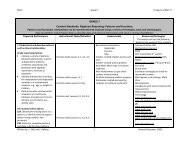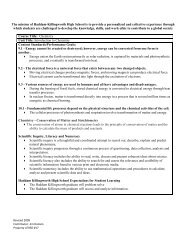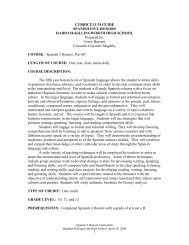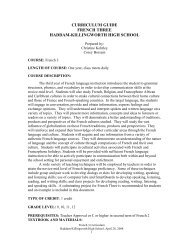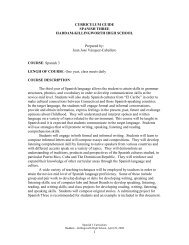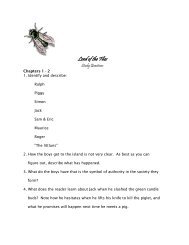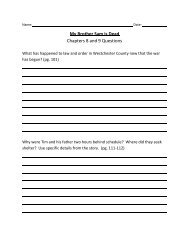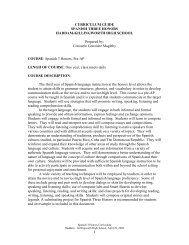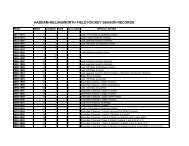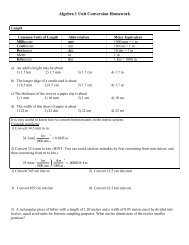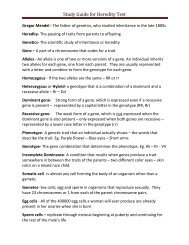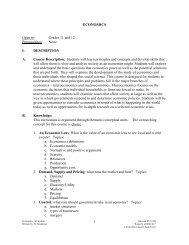Polymers
polymers powerpoint
polymers powerpoint
- No tags were found...
Create successful ePaper yourself
Turn your PDF publications into a flip-book with our unique Google optimized e-Paper software.
1. Build a molecule of ethane, ethene andethyne.2. Build a molecule of butane and then buildan isomer of butane (isobutane).<strong>Polymers</strong>Carbon-based compounds
<strong>Polymers</strong>Carbon-based compounds1. INFER:1. How does JELLO (a carbon-based compound)become a solid?2. How does your body produce hair, muscleand skin?3. How can they make a solid plastic out ofliquid petroleum, or rubber out of liquidsap?
MOLECULES OF LIFEWe are all CBLF’s (carbon-based life forms)•CARBON CAN FORM AN INCREDIBLE VARIETY OFMOLECULES!!!
B. STRAIGHT OR BRANCHED CHAINSC. ISOMERS
D. RINGS - AromaticsEach corner represents a carbon atom.Ring size can vary from three to eight.
POLYMERS• Carbon atoms can bond to one another in chains toPolyethyleneform a variety of structures, including fossil fuelssuch as coal, synthetic polymers such as plastics, andthe large molecules of life, such as proteins andlipids.LipidMolecular structure of Coal
All of this allows Carbon to create:GIANT MOLECULES called POLYMERS100’s to 1000’s of smaller molecules joined together.<strong>Polymers</strong> ARE CHAINS OF Monomers joined together.
All of this allows Carbon to create:GIANT MOLECULES called POLYMERS100’s to 1000’s of smaller molecules joined together.<strong>Polymers</strong> ARE CHAINS OF Monomers joined together.monomerpolymer
POLYMERS (the whole train) are made out of MONOMERS(individual cars of the train) joined together.
POLYMERS (Macromolecules)
Carbon <strong>Polymers</strong> - Journal1. Define “polymer”. Define “monomer”.2. Name the 3 main types of polymers and give anexample of each3. Draw the structural formula for the monomer“ethylene” and part of the structural formula forthe polymer “polyethylene”4. Define polymerization5. What is a “Catalyst”? (use your resources)
<strong>Polymers</strong>• Polymerization: When carbon moleculescombine into long chains.• HOW: This happens when a carbon to carbondouble bond in a monomer is broken and newsingle bonds are formed creating a polymer.http://www.tvo.org/iqm/plastic/animations.html#
<strong>Polymers</strong>• Polymerization of polypropylene (propene).
<strong>Polymers</strong>Polymerization: (of polyethylene)
<strong>Polymers</strong>Polymerization: (of nylon)
<strong>Polymers</strong>Living organisms form biopolymers such ascarbohydrates, proteins, lipids and nucleic acidsthrough polymerization.
POLYMERSFOUR TYPES OF ORGANIC POLYMERS:1. CARBOHYDRATES – glucose, bread, pastaCARBO(C) – HYDRATE(H 2 O)2. PROTEINS – muscle, meat, hair, nails3. LIPIDS – fat, oil, butter4. NUCLEIC ACIDS – DNA, RNA>ALL CONTAIN C, H, AND O>C—C BONDS ORGANIC COMPOUNDS
<strong>Polymers</strong>: ProteinsPolymerization of a protein: putting simplemonomers together.
<strong>Polymers</strong>: ProteinsPolymerization of a protein: putting simplemonomers together.monomer monomer monomer monomerWhere will the monomers JOIN TOGETHER?
<strong>Polymers</strong>: ProteinsPolymerization of a protein: putting simplemonomers together.monomer monomer monomer monomerWhere will the monomers JOIN TOGETHER?
<strong>Polymers</strong>: ProteinsPolymerization of a protein: putting simplemonomers together.Water drops out to allow the bonds to form.
<strong>Polymers</strong>: ProteinsPolymerization of a protein: putting simplemonomers together.
<strong>Polymers</strong>NOT ALL REACTIONS CAN GO BY THEMSELVES.Catalyst: A chemical substance that STARTS orINCREASES the rate of a reaction without beingused in the polymer.http://www.cem.msu.edu/~reusch/VirtualText/mechism/polvincl.htm
<strong>Polymers</strong>Catalyst: A chemical substance that increases therate of a reaction without being consumed.
Carbon <strong>Polymers</strong> - Review1. Carbon atoms bonded to one another in chains2. 3 TYPES: fossil fuels, synthetic polymers, andbiopolymers3. Formed through a process called polymerization4. Catalyst: STARTS or INCREASES the rate of thereaction without being used up
Carbon <strong>Polymers</strong> - Journal1. Come in2. Have a seat3. Silently read the article from the back
Carbon <strong>Polymers</strong> - Journal1. Write down the name, and some of the propertiesof the plastic on your desk.2. Quick draw an image of both the monomer andpolymer of ethylene.3. Re-Read the Polymer Lab Sheet from the back ofthe room.4. Choose which test (tensile, abrasion, puncture) thatyou would want to run, and begin filling out theback of the sheet.


